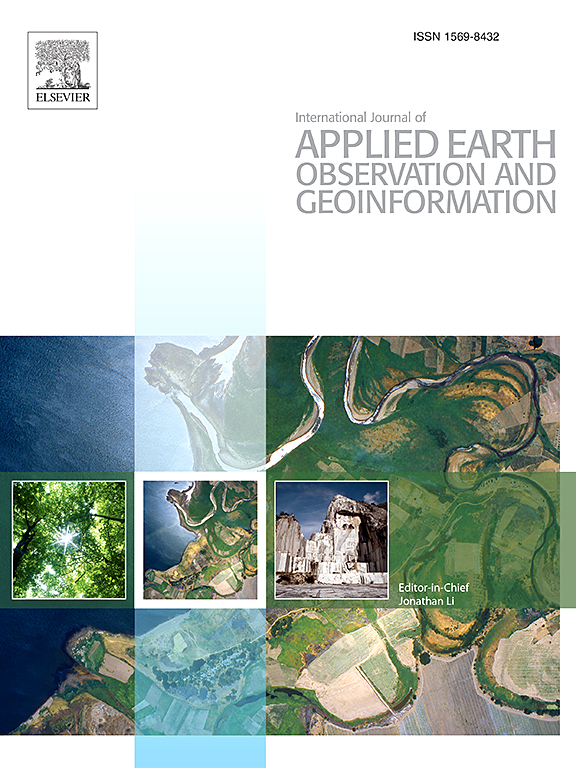城市内部形态的普遍模式:使用无监督聚类定义城市结构的全球类型
IF 8.6
Q1 REMOTE SENSING
International journal of applied earth observation and geoinformation : ITC journal
Pub Date : 2025-05-29
DOI:10.1016/j.jag.2025.104610
引用次数: 0
摘要
城市的物理维度及其空间格局在塑造社会和城市动态方面发挥着至关重要的作用。理解城市系统的复杂性需要对其物理结构进行详细的评估。城市地理学长期以来一直专注于使用各种方法构建类型学,以表示城市结构中的共同模式。然而,只有最近在计算方法和全球土地覆盖数据方面的进步,才能通过新的无监督方法在城市尺度上全面确定城市格局的类型。然而,在城市内部尺度上的细粒度模式的类型学尚未在全球范围内进行全面探索。在本文中,我们以这些进展为基础,探讨了全球1500多个城市的城市内部模式。我们依靠局部气候区土地覆盖分类来表示城市内部形态的多维变化。采用基于深度学习的无监督聚类方法,我们发现了138个城市内模式的类型。分析这种数据驱动方法的结果,我们证明了所识别的每个模式在其组成和配置上都是唯一的,即统计上不同。这项研究总结了全球城市结构的多样性,揭示了世界上任何一个城市都可以被描述为这138种普遍模式的一部分的特定组合。这些普遍模式揭示了在全球范围内,城市内部结构中低密度的建筑形式占主导地位。本文章由计算机程序翻译,如有差异,请以英文原文为准。

Universal patterns of intra-urban morphology: Defining a global typology of the urban fabric using unsupervised clustering
The physical dimension of cities and its spatial patterns play a crucial role in shaping society and urban dynamics. Understanding the complexity of urban systems requires a detailed assessment of their physical structure. Urban geography has long focused on framing typologies to represent common patterns in the urban fabric using various methodologies. However, only recent advancements in computational methods and global land cover data have enabled to comprehensively identify typologies of urban patterns at the city scale through new unsupervised approaches. Nevertheless, typologies of finer-grained patterns at intra-urban scale have not yet been explored comprehensively at a global level. In this paper, building upon these advances, we explore the intra-urban patterns of more than 1500 cities across the globe. We rely on a Local Climate Zone land cover classification to represent the multidimensional variabilities of intra-urban morphology. Adapting a deep learning based unsupervised clustering approach, we find a typology of 138 intra-urban patterns. Analyzing the results of this data-driven approach, we prove that each pattern identified is unique, i.e. statistically different, in its composition and configuration. With this study summarizing the global diversity of the urban fabric, we reveal that any city of the world can be described as a specific assemblage of a fraction of these 138 universal patterns. These universal patterns reveal a predominance at a global scale of built-up forms of low density in the intra-urban fabric.
求助全文
通过发布文献求助,成功后即可免费获取论文全文。
去求助
来源期刊

International journal of applied earth observation and geoinformation : ITC journal
Global and Planetary Change, Management, Monitoring, Policy and Law, Earth-Surface Processes, Computers in Earth Sciences
CiteScore
12.00
自引率
0.00%
发文量
0
审稿时长
77 days
期刊介绍:
The International Journal of Applied Earth Observation and Geoinformation publishes original papers that utilize earth observation data for natural resource and environmental inventory and management. These data primarily originate from remote sensing platforms, including satellites and aircraft, supplemented by surface and subsurface measurements. Addressing natural resources such as forests, agricultural land, soils, and water, as well as environmental concerns like biodiversity, land degradation, and hazards, the journal explores conceptual and data-driven approaches. It covers geoinformation themes like capturing, databasing, visualization, interpretation, data quality, and spatial uncertainty.
 求助内容:
求助内容: 应助结果提醒方式:
应助结果提醒方式:


